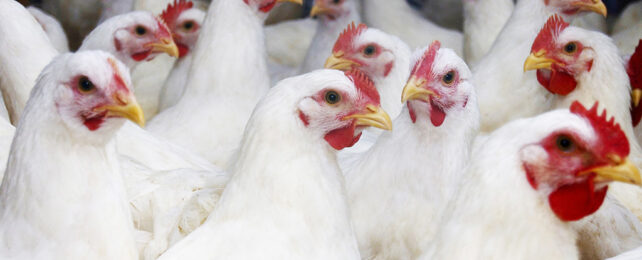Bird flu appears to have spread from a Colorado dairy farm to a nearby poultry farm, infecting five human workers who had been tasked with culling the affected birds.
The highly infectious virus, avian influenza H5N1, has pandemic potential, and the race is on to create a vaccine to curb its disastrous effects.
The US Centers for Disease Control and Prevention (CDC) confirmed four of the human cases that sprang from the commercial egg laying business. While the fifth case is pending CDC confirmation, it's also presumed positive at this stage.
There's currently not enough evidence to determine the source and route of the poultry farm infection, but it's hypothesized that the virus jumped from dairy cattle to the poultry farm.
"Genomic sequencing of samples from the poultry operation confirms the same type of genotype of highly pathogenic avian influenza that is in the nearby dairy herds," acting senior adviser Eric Deeble from the US Department of Agriculture said at a press briefing on Tuesday, recorded by CBS journalist Alexander Tin.
This isn't enough to trace the virus's interspecies travels, but it does suggest the virus is capable of thriving in a variety of animal hosts, without having to mutate much.
This possibility has scientists greatly concerned. The more species a virus can jump between, the more efficiently it can spread. Cows in the US first began to contract avian flu earlier this year, with the virus spreading to two humans.
"CDC's assessment of the risk to the general population remains low, and CDC has not changed its recommendations," principal deputy director of the CDC Nirav Shah said in the press briefing.
"For example, CDC is not recommending H5 specific vaccines for livestock workers given the mild symptoms that have been noted thus far, and the absence of any changes to the virus's genetic makeup that would suggest that the risk to human health is increased."
He said a preliminary analysis of the virus's genes, collected from one of the infected poultry farm patients, did not show any mutations of concern.
"The sequence is very closely related to two sequences from infected chickens from the farm where the worker was likely exposed," Shah said.
"And in addition to that, one of the virus's subunits was 100 percent identical to the Texas and the first human case from Michigan."
While symptoms in humans so far seem to be mild, and recovery speedy, the greater concern may be the impact this could have on agriculture.
The milk from cows with the virus is rendered unsafe for consumption, and culling to prevent further spread – like the 1.8 million birds at the Colorado poultry farm in question – leaves a massive dent in livestock numbers.
It's these culls that appear to place humans at higher risk of infection. The five infected workers were among employees tasked with loading birds into carbon dioxide gas chambers for culling, the Colorado Department of Public Health and Environment reports.
"There were large scale industrial fans that certainly helped keep the barns cool, but those fans also spread things like feathers around, which are known to carry the virus," Shah said.
"In addition, the culling method that was used here entailed workers moving from chicken to chicken, increasing the degree of interaction with each potentially infected bird."
While PPE for this unpleasant task is usually extensive, workers likely struggled to maintain these measures as the temperatures in Colorado climbed to at least up to nearly 40 °C (104 °F) on the day, Shah said at the briefing.
An industrial hygienist has been enlisted to investigate strategies for better transmission prevention.
